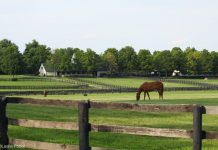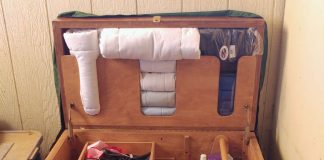 |
| Bees can make a hive inside the trunk of a large shade tree. Creating a barrier of foam or wood is only a temporary fix. |
Can bees and horses live in harmony? That all depends. The typical honeybee is gentle and when foraging among wildflowers. But if you accidentally disturb a hive they can turn ornery in an instant. Meanwhile, the African strain of honeybees, which have all but infiltrated the southwest of the United States, is consistently aggressive.
It’s understandable why horses panic when they encounter a swarm of bees. If your horse is attacked by bees while it’s tied up or confined in a corral, keep in mind that you could be risking your life with a rescue attempt. The horse will be consumed with fleeing and won’t really care if you are blocking the one and only escape route. Shield your face as much as possible and open the gate or unsnap or untie the horse, and run out of the way. If you disturb a swarm or hive while trail riding, gallop away as fast as possible. Do not flail your arms or yell, as that will only agitate the bees further.
These tips are doubly important if you notice a so-called “ball of bees.” When a hive becomes crowded, several thousand bees will leave to establish a new home. When it comes time to rest and cool off, they’ll attach themselves to something like a tree limb, forming one imposing buzzing mass. Never use the hose to squirt them away, even if they’ve hanging out near your wash rack. That’ll only alert the sentinel bees who are patrolling the air space around the swarm. Also, some strong scents, including those found in some fly sprays, have actually been shown to attract or provoke bees. Therefore, it’s probably wise to choose fly sprays that lack an antiseptic or otherwise strong odor when trail riding. The same goes for human sunscreen products. Merely applying scented sunscreen before a riding lesson or trail ride can make you the target of a bee attack.
Become proactive and remove any possible habitats for traveling bee swarms. Look around your barn for overturned mangers or stacks of pallets. A rarely used horse trailer or the loft of a tack room or hay barn can also become a home to bees. Another favored site for a bee hive is the trunk of a large, mature tree. Such trees often have hollow spaces inside the nooks and crannies of the trunk. Tens of thousands of bees can take up residence inside the trunk of an unassuming shade tree and become a bomb of bees just waiting to go off. Finally, be aware that bees need a water source. Water troughs and puddles attract bees. If your horse suddenly stops drinking from the trough in its pasture, investigate the site for bees.
Never attempt to do it yourself when it comes to bee removal. Even placid honeybees are protective of their hive and when provoked will attack you and any nearby horses. Unless you’re well versed in apiary science, you could end up leaving behind honey and honeycomb, which will continue to lure future swarms of bees. And don’t think that creating a barrier of plywood or expandable foam will work for long. Bees are incredibly determined. They’re also small but mighty. Over time, they can even eat through drywall in a house! These are all reasons why it’s best to contact a reputable beekeeper who will either harvest the bee population (plus the honey) or exterminate the bees and thereby remove the hive for safety reasons.
As horse lovers we have a special place in our hearts for all of nature. But when it comes to bees it’s best to beware.
Read more on stinging insects >>
Create an emergency first aid kit >>






thank for the tips!
interesting article
Thank you for a wonderful article with great tips
I was stung three times this summer around the barn. The bees really liked the fresh hay we got. Thanks for the tips. I don’t want to get stung again!
Thank you for this article. It is good to be careful not to get stung. Some people are allergic too. I have never been stung and hope not to.
good information
Thanks for the info about the bees.
One thing to keep in mind is that a ball of bees is not going to attack you. They don’t have a hive to protect and they are quite docile.
Unfortunately, a friend of mine just lost her life while riding because her horse stepped into a wasps’ nest and panicked. She was thrown and broke her neck. The dangers are very real.
This was a great article! Very informative!
wow
great article
Does anyone know what the specific ingredients in fly sprays are attractive to bees?